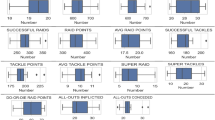Abstract
In the following paper, we design a model that uses real-time data to segregate players into categories according to their performances in the T-20 tournaments. The data are gathered from reliable websites, cleaned and analysed through cluster space maps based upon certain proposed formula. A thorough research on players’ statistics with different unsupervised clustering algorithms in machine learning and deep learning models is documented and compared through silhouette scores. They are classified based on their strength according to bowlers, batsmen and all-rounders. A comparative study of machine learning algorithms with its deep learning counterparts using auto-encoder is also shown. The paper depicts how the models perform on the given dataset and concludes with the most effective model.



















Similar content being viewed by others
References
Wickramasinghe IP (2014) Predicting the performance of batsmen in test cricket. J Hum Sport Exercise 9:744–751
Perera H, Davis J, Swartz TB (2016) Optimal lineups in Twenty20 cricket. J Stat Comput Simul 86:2888–900
Davis J, Perera H, Swartz TB (2015) Player evaluation in Twenty20 cricket. J Sports Anal 1:19–31
Sankaran S (2014) Comparing pay versus performance of IPL bowlers: an application of cluster analysis. Int J Perform Anal Sport 14(1):174–187
Khan JR, Biswas RK, Kabir E (2019) A quantitative approach to influential factors in One Day International cricket: analysis based on Bangladesh. J Sports Anal 5:57–63
Cohen GL (2002) Cricketing chances. Abstracts from the 6th Australian conference on mathematics and computers in Sport, 1–3 July 2002, pp 1–14
Patil AJ, Patil CS, Karhe RR, Aher MA (2014) Comparative study of different clustering algorithms. Int J Adv Res Electr Electron Instrum Eng 3:10490–10497
Irvine S, Kennedy R (2017) Analysis of performance indicators that most significantly affect International Twenty20 cricket. Int J Perform Anal Sport 17(3):350–359
Douglas MJ, Tam N (2010) Analysis of team performances at the ICC World Twenty20 Cup 2009. Int J Perform Anal Sport 10(1):47–53
Moore A, Turner JD, Johnstone AJ (2012) A preliminary analysis of team performance in English first-class Twenty-Twenty (T20) cricket. Int J Perform Anal Sport 12:1:188–207
Petersen C, Pyne DB, Portus MJ, Dawson B (2008) Analysis of Twenty/20 Cricket performance during the 2008 Indian Premier League. Int J Perform Anal Sport 8(3):63–69
Daniyal M, Nawaz T, Aleem IMM (2012) Analysis of batting performance in cricket using individual and moving range (MR) control charts. Int J Sports Sci Eng 6(4):195–202
Lemmer H (2008) Measures of batting performance in a short series of cricket matches. South Afr Stat J 42(1):65–87
Amin GR, Sharma SK (2014) Cricket team selection using data envelopment analysis. Eur J Sport Sci 14(sup1):S369–S376
Jayanth SB, Anthony A, Abhilasha G, Shaik N, Srinivasa G (2018) A team recommendation system and outcome prediction for the game of cricket. J Sports Anal 4:263–73
Barr GDI, Kantor BS (2004) A criterion for comparing and selecting batsmen in limited overs cricket. J Oper Res Soc 55:1266–1274
Forrest D, Dorsey R (2008) Effect of toss and weather on County Cricket Championship outcomes. J Sports Sci 26:3–13
Dawson P, Morley B, Paton D, Thomas D (2009) To bat or not to bat: an examination of match outcomes in day-night limited overs cricket. J Oper Res Soc 60:1786–1793
Mitra S, Patra T, Ghosh R, Ghosh S, Bose A (2019) Framework for appraisal of twenty-twenty league players. In: Global AI congress
Saikia H, Bhattacharjee D, Lemmer HH (2012) Predicting the performance of bowlers in IPL: an application of artificial neural network. Int J Perform Anal Sport 12:75–89
Prakash CD, Patvardhan C, Singh S (2016) A new machine learning based deep performance index for ranking IPL T20 Cricketers. Int J Comput Appl 137:42–49
Jain SS, Gupta R, Tiwari C, Kaur N (2019) Behaviour of players on IPL based on fuzzy C means. Int J Innov Technol Explor Eng (IJITEE) 8(9):150–154
Lee H, Park KH, Bien ZZ (2008) Iterative fuzzy clustering algorithm with supervision to construct probabilistic fuzzy rule base from numerical data. IEEE Trans Fuzzy Syst 16(1):263–277
Wang Y, Yao H, Zhao S (2015) Auto-encoder based dimensionality reduction, neurocomputing. Elsevier, Amsterdam
Bruno G, Cerquitelli T, Chiusano S, Xiao X (2014) A clustering-based approach to analyse examinations for diabetic patients. In: IEEE international conference on healthcare informatics
Spearman C (1904) General intelligence objectively determined and measured. Am J Psychol 15:206–221
Torgerson WS (1952) Multidimensional scaling I: theory and method. Psychometrika 17:401–419
Jain AK (2010) Data clustering: 50 years beyond K-means. Pattern Recognit Lett 31:651–666
Tan CC, Eswaran C (2008) Performance comparison of three types of autoencoder neural networks. In: Second Asia international conference on modelling & simulation
Pearson K (1901) On lines and planes of closest fit to systems of points in space. Philios Mag 2:559–572
Shah P (2017) New performance measure in Cricket. ISOR J Sports Phys Educ 4:28–30
Kanhaiya K, Gupta R, Sharma AK (2019) Cracked cricket pitch analysis (CCPA) using image processing and machine learning. Global J Appl Data Sci Internet Things 3:1
Author information
Authors and Affiliations
Corresponding author
Additional information
Publisher's Note
Springer Nature remains neutral with regard to jurisdictional claims in published maps and institutional affiliations.
Rights and permissions
About this article
Cite this article
Bose, A., Mitra, S., Ghosh, S. et al. Unsupervised Learning Based Evaluation of Player Performances. Innovations Syst Softw Eng 17, 121–130 (2021). https://doi.org/10.1007/s11334-020-00374-3
Received:
Accepted:
Published:
Issue Date:
DOI: https://doi.org/10.1007/s11334-020-00374-3




